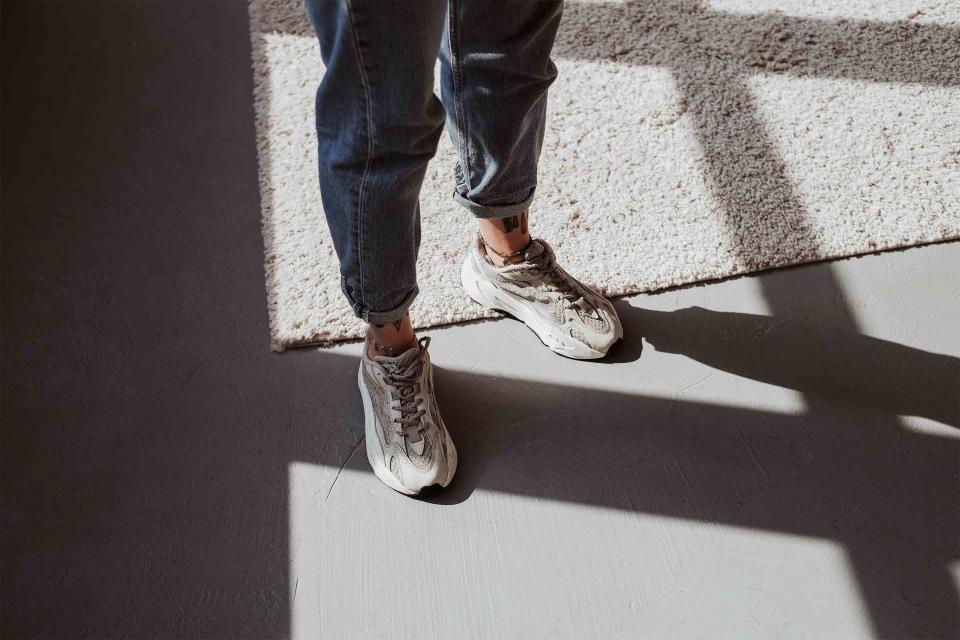How to Stop Foot Pain From Standing All Day, According to a Podiatrist
Say goodbye to foot pain with expert tips

Getty Images
Depending on what you do for work or your lifestyle in general, standing for prolonged periods of time might be unavoidable. Of course, staying active and on your feet is better for your health than sitting at a desk all day, but if you're not taking care of your feet properly, it can have negative impacts on the rest of your body, and even your mental health.
If you're someone who has to stand all day or is always on their feet, we tapped Dr. Brad Schaeffer, Board Certified Podiatrist and Foot Surgeon at Central Park SOLE and star of TLC's My Feet Are Killing Me, to make sure you learn how to take the proper precautions so your foot health doesn't begin to impact the rest of your total wellbeing. Here's what you need to know about choosing the right footwear, inserts, and more to maintain total body health if you're on your feet all day.
5 Expert Tips for Reducing Foot Pain If You Stand All Day
If you're someone who stands all day, you probably already know the body strains this leads to that can eventually turn chronic. "Prolonged standing can result in health consequences such as backaches, muscle fatigue, and leg and foot cramps," explains Dr. Schaeffer. "The added stress to our bodies due to long-term, prolonged standing can also result in arthritis and high blood pressure." That means taking care of your foot health can be beneficial for all other health avenues in the body. Here's what you need to know.
Related: The 10 Best Sneakers for Standing All Day of 2023, According to Podiatrists
Choose the Right Footwear
Choosing the right footwear can greatly improve any foot pain you're feeling, so this is a great place to start if you're beginning to notice foot pain for the first time. Here are a few quick tips from Dr. Schaeffer on how to choose footwear based on the pain you're feeling.
If you're noticing frequent, all-over foot pain, look for a shoe with better arch support.
If you notice pain only in the heel, you may have plantar fasciitis, which is a condition that affects people with higher arches. Orthotic insoles, such as Dr. Scholl's Plantar Fasciitis All Day Relief insoles can help.
When shopping for shoes, Dr. Schaeffer suggests bringing a traced outline of your foot with you, and "steer clear from any shoes that are shorter or narrower than the tracing."
Forget the myth of "breaking shoes in." Dr. Schaeffer says shoes should feel comfortable from the moment you try them on.
Look for shoes with a stable heel cup and wide box
Related: We Tested Dozens of Running Shoes — And These Were Best for Plantar Fasciitis
Maintain Proper Posture
According to Dr. Schaeffer, there are many posture techniques you can try right away to improve foot pain. "Remembering to stand with your hips shoulder lengths apart can help evenly distribute your weight on your feet rather than leaning onto one leg or putting pressure on your heels," he says.
Related: The Best Way to Correct Posture, According to Experts
Use Supportive Insoles or Orthotics
We already touched on insoles a bit above, but you shouldn't sleep on this foot pain fix since, according to Dr. Schaeffer, they can have real, tangible results. First, it's important to understand what type of feet you have before you choose insoles or orthotics.
"Some people are flat-footed, have high arches, have heel spurs or bunions. Insoles simply aid your feet in the right direction so that the rest of your body falls into place," says Dr. Schaeffer. "When choosing the right insoles, assess your feet or consult a professional to figure out what type of feet you have." Basically, you choose your insole based on the type of foot you have. The goal is to feel stabilized and supported each time you take a step.
You should consider custom orthotics if you have chronic foot pain that's affecting other parts of the body. "Benefits of custom orthotics include better balance, reduced pain from the feet up to the lower back, correcting foot abnormalities, improving your overall posture, and lasting longer on your feet," explains Dr. Schaeffer. "If you need a little more TLC with your feet like a chronic problem, orthotics would be your answer."
Practice Footcare and Pain Management
Of course, overall foot hygiene can contribute to better foot health. If your toenails are too long, they could be pushing against your shoe, causing toes to be cramped and sore, thus bringing on foot pain. Topical pain relief creams can help heal this issue in the interim before you can purchase insoles or orthotics.
Soaking feet in a warm, Epsom salt bath can help relieve pain by helping to increase circulation and help with inflammation. Trying out foot reflexology or massage may also be helpful.
Strengthen and Stretch Foot Muscles
Like any other part of your body, working out your feet can help strengthen them, which can help you avoid foot pain later on. "A great exercise for feet is walking barefoot on sand," suggests Dr. Schaeffer. "It's a great way to stretch and strengthen the feet and calves. Additional beneficial stretches are toe raises, toe points, and toe curls."
If stretching doesn't seem to be helping and foot pain is chronic, it might be time to reach out to a professional. You might need more serious stretching/training from a physical therapist to help realign your body and alleviate lingering foot pain.
For more Shape news, make sure to sign up for our newsletter!
Read the original article on Shape.

